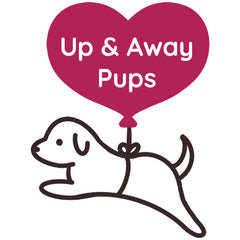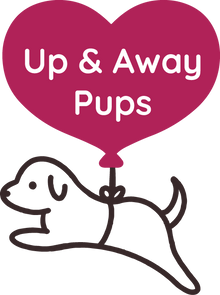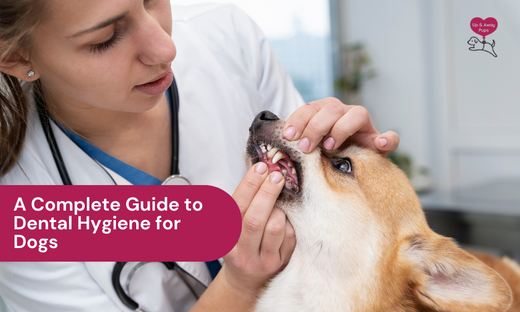A Complete Guide to Dental Hygiene for Dogs
Bad breath in dogs is often overlooked, but it can signal dental issues like gum disease, plaque buildup, or cavities. This comprehensive guide highlights the importance of maintaining your dog’s oral health with regular brushing, dental wipes, and professional cleanings. Learn how to spot signs of dental problems, such as bleeding gums or changes in behavior, and discover tips for introducing dental care routines. With proper oral hygiene, you can prevent discomfort and ensure your furry friend stays happy and healthy.
As dog parents and lovers of animals in general, we get used to the stinky breath of our furry little friends. A small price to pay for dealing with their horrendous breath, for the cuteness and joy they bring to the table, right? Well, yes and no. While we would absolutely deal with the stinky breath of our dogs, as we already do, we don’t really have to. Dogs having bad breath is so normalized that we don’t even realize it’s not supposed to be that bad. If it is, it usually is a sign of something being off. In this blog, we’ll talk about the much-needed but less spoken-about topic of oral hygiene for dogs.
The Severe Lack of Awareness
Among pet parents, it is largely observed that dental hygiene for dogs isn’t particularly a matter of discussion. It has almost become a meme that dogs just have bad breath. This neglect results in, as research shows, 80% of dogs developing dental conditions by the age of 3, with gum disease being the major culprit. Admittedly, bad breath alone cannot be an indication of bad oral hygiene, as it could be caused by other factors like gastrointestinal issues, other health problems, or dogs just doing dog activities.
While it isn’t fair to say all pet parents ignore their dogs' dental hygiene, some do actively brush their pets' teeth and ensure no leftover food is stuck in their teeth. However, plaque, which is largely invisible to the naked eye, can often go unnoticed. If left there for too long, it becomes tartar, at which point the classic toothpaste and brush combination won’t do; you’re going to have to go to a vet. Even after the visit, plaque will simply start forming again within a day. The solution is being proactive.
Knowing When Your Dog’s Teeth Requires Attention
Dogs, even if they’re as smart as a Miniature Labradoodle, cannot tell you their teeth hurt. One must actively keep an eye out for signs that signal something wrong with their dental hygiene. Here are some common symptoms to look out for:
Bad breath (halitosis):
Admittedly, your dog’s breath is never going to be pleasant, and that is completely fine. With that said, it ought not to smell foul either. This is usually a sign of tartar buildup, gastrointestinal issues, or gum disease. If you notice your dog’s appetite being low or if they’re vomiting, a visit to the vet is recommended.

Gums and Teeth:
Gums are supposed to be pink in color; any other color is usually a sign of something being wrong. Make sure you notice the gums and teeth of your dog while brushing. Look for discoloration, bleeding, or signs of swelling/inflammation. Missing a tooth or a loose tooth is an indication that you should visit the vet. Loose or missing teeth in puppies, though, is normal.
Changes in Behavior:
If your dog is in pain, their behavior will also be influenced. Pain from dental issues will make them more irritable and a lot less active than usual.
Diseases Caused by Dog Oral Health
Knowing the common dental problems that dogs may face is the very first step in ensuring your precious fur baby isn’t affected by them. Here are the most commonly observed types of dog dental problems:
Periodontal Disease
Periodontal disease, also known as gum disease, is the most common dog oral health issue, with around two-thirds of dogs having it by the age of just three years old. This condition can be quite painful too. It starts off as gingivitis, and if left untreated, it can result in tooth loss. In extreme cases, bacteria from the gums can enter the bloodstream, affecting the heart, kidneys, and liver.
Tooth Decay and Cavities
While cavities are less common in dogs than in humans, they can still occur, especially if your dog eats sugary foods or treats. Tooth decay develops when bacteria in the mouth break down food particles, leading to holes in the teeth. This can cause pain, infection, and even tooth loss.
Tartar and Plaque Build-Up
Tartar and plaque are common dental issues that affect dogs of all ages. Plaque forms when bacteria mix with food particles in your dog’s mouth. If plaque is not removed, it hardens into tartar, which can only be removed by a professional cleaning at the vet.
Maintaining Oral Hygiene for Dogs
The best thing you can do to maintain your dog’s oral hygiene is to start early. There’s no better time to start than when they’re puppies, but it can be taught at all ages. Older dogs can learn new tricks. Just like how missing a brushing session would leave a bad taste in our mouth, no pun intended, as a pet parent, you ought to apply the same standards of discipline for your dog. Remember that bad oral hygiene in dogs can potentially lead to much greater issues down the line.
Introducing the Technique
The biggest challenge of, really, performing any sort of health-related procedure on animals is that they cannot understand it’s for their own good. They need to be convinced about it. As we mentioned above, the sooner you start, the better. If you’ve got yourself an adorable Teacup Teddy Bear pup, start to gently get them accustomed to the motion. Put some treats on your finger, gently pull back your dog’s mouth, and touch their teeth and gums in the typical brushing-your-teeth motion. This will get them used to the motion while building a positive connection between the two. Remember, positive reinforcement often works the best.
If you have an older dog, you have to be a little more gentle and patient as they might not be used to or comfortable with getting their mouths touched. However, the same technique of building a positive relationship will work here as well.
In comes The Toothbrush
Once your dog is used to your fingers, introduce the toothbrush. Whilst you can use both the traditional toothbrush and the electric one, we personally recommend using the electric one as it does a much better job at cleaning.
Do you need a Toothpaste?
Yes, and no. At-home dental care for dogs advocates recommend the usage of coconut oil which does indeed do a fine job but a vet-recommended toothpaste, too, does the trick. So, as a pet owner, you can make the decision and pick whichever best suits you and your dog.
How Often Should You Brush Your Dog’s Teeth
Oral hygiene for dogs is simultaneously complicated and simple. On one hand, it is best to simply create a routine in which you brush your dog’s teeth every day. However, some dogs have teeth that stay in great shape despite never brushing for years. So, how do you determine what to do?

The former advice is great. Just like for us, daily brushing for dogs, around 2 minutes every day, should be the baseline. The exact frequency of brushing and how long you should do it depends largely on the plaque and tartar buildup in the mouth.
Dental Wipes and Treats
Dental wipes and treats (and chew toys) are often used as an alternative to brushing, and we’re all for it. Dogs naturally love chewing, so the sensation of chewing on something feels a lot more natural to them, and they can keep at it for a long time. It also deals with bad breath to a great extent. However, not all treats are the practical alternative to brushing that companies might lead you to believe. Not all treats are made equal. Look for treats that are approved by veterinary dental associations, such as the Veterinary Oral Health Council (VOHC). These treats have been scientifically proven to reduce plaque and tartar buildup and are the ones you should opt for. Remember, dental wipes and treats should be used in addition to a brushing schedule.
Also, take into consideration the breed of dog you have. For a tiny dog like the Pug, get a treat that is appropriate to match their cute size.
Conclusion
A great way to look at it is to truly consider your furry friend like your own child. Kids need to brush every day, and so do dogs. Puppies and smaller dogs are especially more susceptible to dental issues. Ensure your dog goes to the doggy dentist every 6 months for a check-up, as well as maintains a proper brushing routine. Discipline is key here.
FAQs
Can I Use Human Toothpaste on My Dog?
That is a big no. Human toothpaste contains ingredients like xylitol, which is toxic to dogs of all breeds. Only use toothpaste that is meant for dogs, ideally one that is recommended for your dog by their vet.
What Are the Signs That My Dog Has Dental Problems?
Common signs of dental issues include bad breath, difficulty eating, excessive drooling, red or swollen gums, and visible tartar or plaque on the teeth. If you notice any of these signs, consult your vet.
Is Professional Dental Cleaning Necessary for Dogs?
Professional dental cleanings are often necessary for dogs. First off, it can be a great start if your dog is already a young adult. Get their canines cleaned and create a routine for maintaining oral hygiene from there. Also, if your dog hasn’t ever had their teeth brushed, it’s more than likely that the tartar buildup on their teeth cannot be removed at home and requires professional attention.
Can I Use Dental Wipes Instead of Brushing My Dog's Teeth?
Dental wipes are a convenient alternative to brushing and can help remove plaque and freshen breath. However, they should be used in addition to regular brushing or professional cleanings for optimal oral health.
Is It Normal for My Dog’s Gums to Bleed When I Brush Their Teeth?
Mild bleeding can occur if your dog’s gums are inflamed or if they’re not used to brushing. However, if bleeding continues or is severe, it could indicate gum disease, and you should see your vet.


